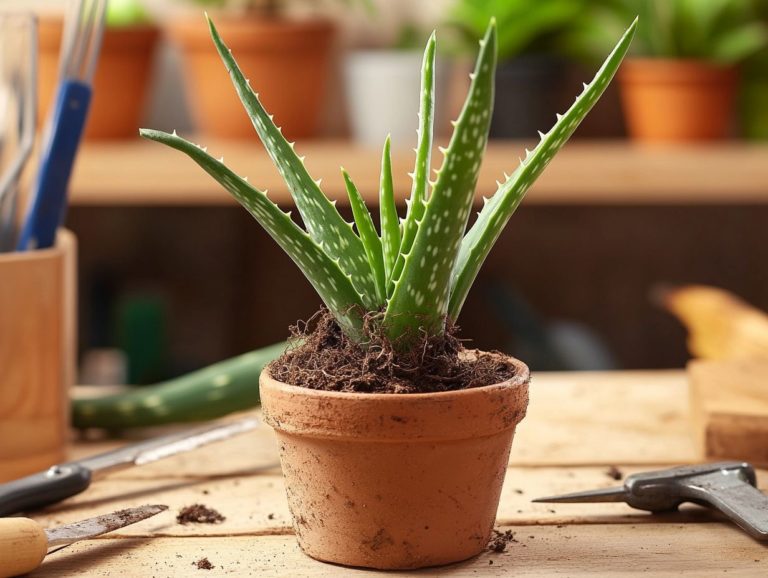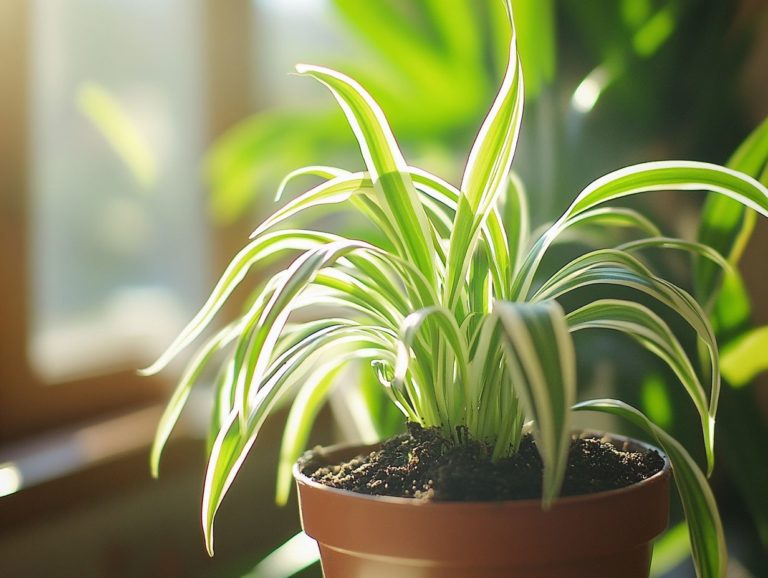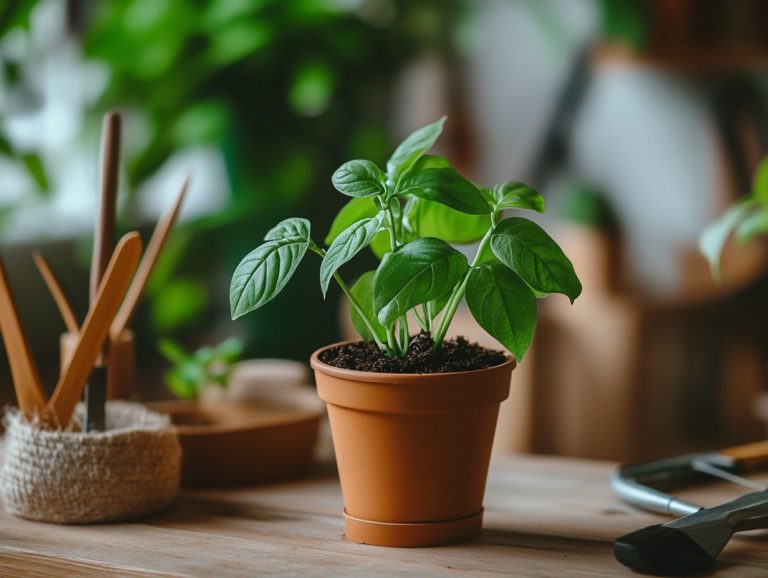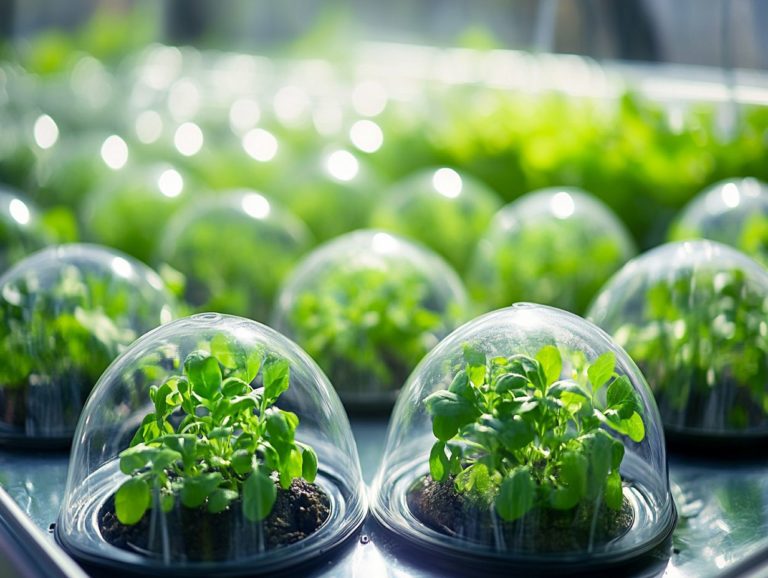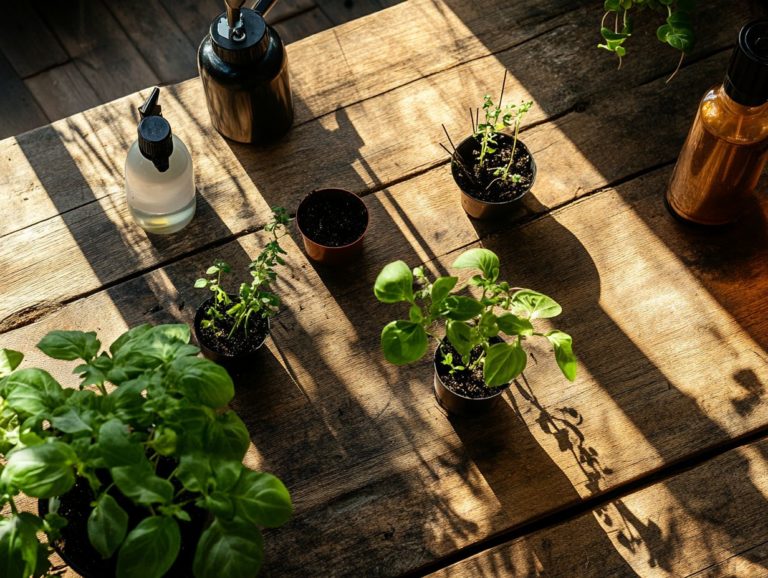Using Propagation Stations for Indoor Plants
If you have a passion for indoor gardening, you ve undoubtedly encountered the concept of propagation stations. These clever setups are indispensable for nurturing new plants from cuttings, allowing you to expand your green oasis right at home.
This article delves into what propagation stations are and the many benefits they offer for plant care. It covers various designs, guides you through the process of setting one up, shares valuable tips for success, and points out common pitfalls to avoid.
Prepare to elevate your indoor gardening experience to new heights with healthy plants!
Contents
- Key Takeaways:
- What are Propagation Stations?
- Benefits of Using Propagation Stations
- Types of Propagation Stations
- Setting Up a Propagation Station
- Tips for Successful Propagation
- Common Mistakes to Avoid
- Frequently Asked Questions
- What is a propagation station; it’s ideal for plant care and propagation?
- Why should I use a propagation station for my indoor plants?
- What types of plants can I propagate in a propagation station?
- How do I use a propagation station for my indoor plants?
- Do I need any special equipment to use a propagation station?
- Can I reuse a propagation station for different plants?
Key Takeaways:
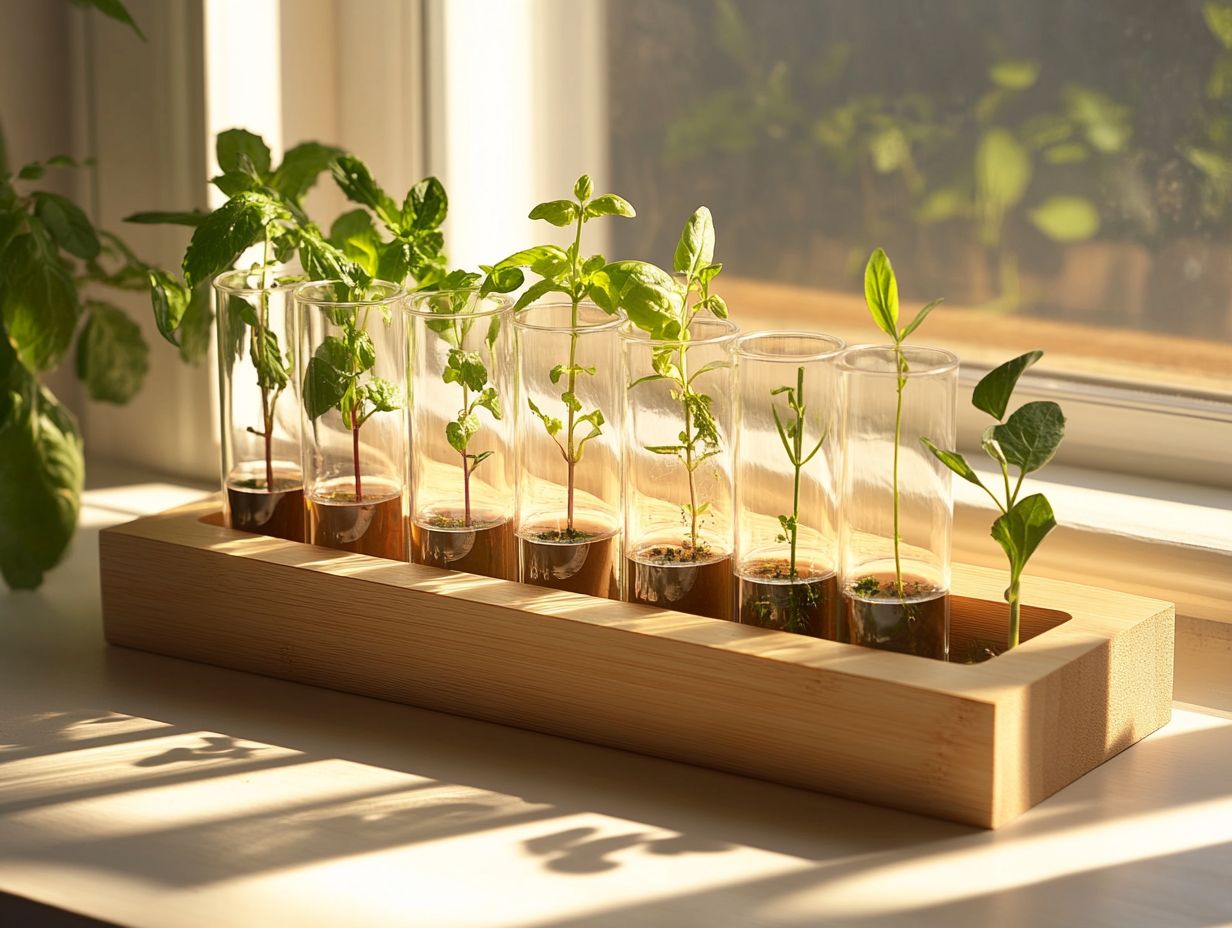
- Propagation stations are specialized tools used to propagate and grow new plants from existing ones. They provide a controlled environment for optimal plant growth and are a cost-effective way to expand indoor plant collections.
- Using propagation stations can significantly benefit indoor plants by promoting faster and healthier growth, increasing success rates for propagation, and allowing for easy monitoring and care. They also create an aesthetically pleasing display for plant enthusiasts.
- There are various types of propagation stations available, each with unique features and designs. Consider factors such as plant type and size, budget, and personal preference when choosing the right one for your indoor plants.
What are Propagation Stations?
Propagation stations are specialized setups that elevate your plant propagation game, making it a breeze to cultivate new plants from cuttings of healthy parent specimens. These stations enhance your indoor gardening experience by creating the perfect environment for various propagation techniques, whether you’re working with stem cuttings, leaf cuttings, or root cuttings.
They ensure that your cuttings develop robust roots, resulting in thriving indoor plants that bring life to any space. Often found in homes and favored by gardening aficionados, propagation stations come in a variety of designs and sizes.
Typically, they feature containers designed to hold water or soil, providing a controlled setting that promotes successful rooting.
Definition and Purpose
The concept of propagation stations centers on their role as dedicated spaces for plant propagation, enabling you to explore various cutting techniques and expand your plant collection.
These specialized setups support a range of methods, including stem and leaf cuttings, which are essential for cultivating new plants from existing ones. When you take stem cuttings from the branches of a parent plant, you encourage rapid root development, leading to vigorous new growth. Leaf cuttings can also work wonders, especially for certain species, where even a single leaf can transform into a new plant over time.
By creating optimal conditions think humidity and warmth propagation stations elevate your indoor gardening experience. They make it easier for you to nurture your green space and delight in the art of cultivation firsthand.
Benefits of Using Propagation Stations
Propagation stations offer great advantages for plant lovers. They help you cultivate thriving indoor plants and simplify your plant care routine.
By employing effective propagation techniques like water rooting and utilizing rooting hormones substances that encourage root growth you can effortlessly turn cuttings into new plants, enriching your indoor garden with an array of species.
Propagation stations provide controlled environments that foster superior root development and overall plant health, giving you the power to expand your collection and enhance the air quality in your home.
How They Help Indoor Plants
Propagation stations significantly enhance your indoor gardening experience by providing a dedicated space for nurturing cuttings until they develop robust roots.
These specialized stations create an environment that maintains optimal humidity and light conditions essential elements for the health of your plants. By allowing your cuttings to flourish in this supportive habitat, you can easily monitor moisture levels using handy gardening supplies like misting bottles and humidity domes.
Many propagation stations also have clear glass containers, which promote better light penetration. This ensures your young plants receive the adequate illumination they need for growth. As a result, these stations not only support your little green companions but also contribute to improved indoor air quality, making your home feel fresher and more vibrant!
Types of Propagation Stations
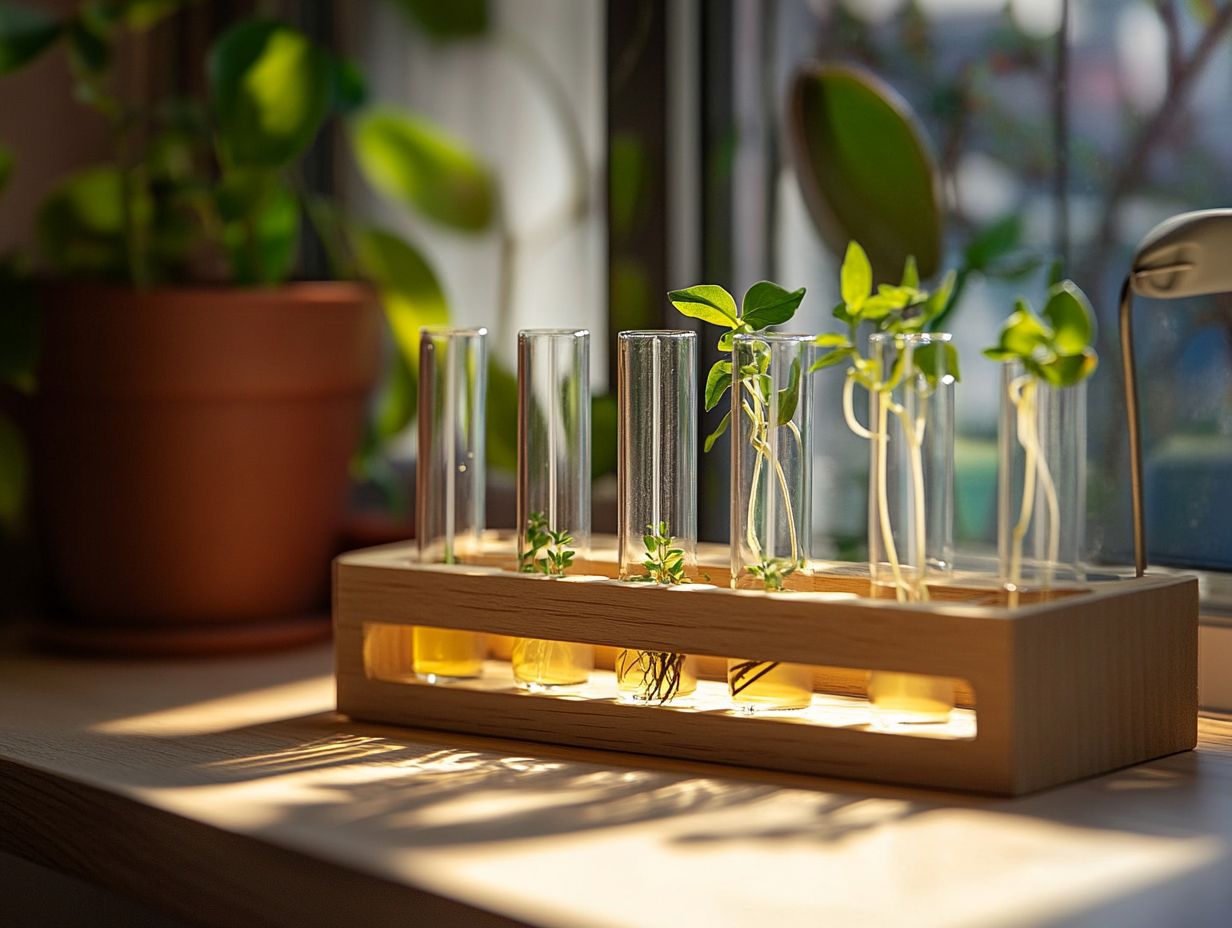
You ll find an array of propagation stations designed to cater to various propagation techniques and indoor plants. Each offers distinct advantages for those looking to elevate their plant collection.
These stations allow you to explore new methods and enhance your gardening experience, making it easier than ever to nurture your green companions.
Comparing Different Designs
When comparing different designs of propagation stations, it s crucial to consider the type of containers used and the methods employed to propagate healthy cuttings. Each design has its own unique benefits and limitations that can greatly influence the success of techniques like water propagation, soil cuttings, or even hydroponics.
For example, a glass propagation station lets you marvel at stunning root development while providing ample light access. However, it might require a bit more attention to humidity levels. On the other hand, plastic trays are lightweight and versatile, making them easy to manage, but they can pose a risk of overwatering if drainage isn t sufficient.
Understanding how these designs work helps you choose the best option for improving your plant growth outcomes, ensuring that the station you select aligns perfectly with your gardening goals and expertise.
Setting Up a Propagation Station
Establishing a propagation station requires you to choose the right materials and follow a series of thoughtful steps. This ensures a successful plant propagation experience.
This meticulous approach transforms the process into a truly rewarding endeavor for gardening enthusiasts like yourself!
Materials and Steps
To establish your propagation station, gather a few essential materials: sharp shears for taking cuttings, propagation containers, water, and optional rooting hormone, a substance that helps plant cuttings grow roots faster.
Don’t overlook the importance of adequate lighting for promoting healthy root development. If natural sunlight is lacking, consider investing in grow lights to ensure your plants thrive. It s also wise to have a moisture meter handy for monitoring humidity levels, helping you keep your cuttings perfectly hydrated.
Choosing the right medium, whether it s perlite or potting soil, can make a significant difference in your propagation efforts. As you collect these supplies, think about creating a setup that is both functional and visually appealing. Arrange your containers in a way that inspires growth and sparks your creativity!
Tips for Successful Propagation
Successful propagation demands a blend of best practices and expert insights that empower you to achieve optimal growth from your plant cuttings.
By integrating these strategies, you can elevate your gardening experience and cultivate thriving plants with confidence!
Start your propagation journey today and watch your indoor garden thrive!
Best Practices for Plant Growth
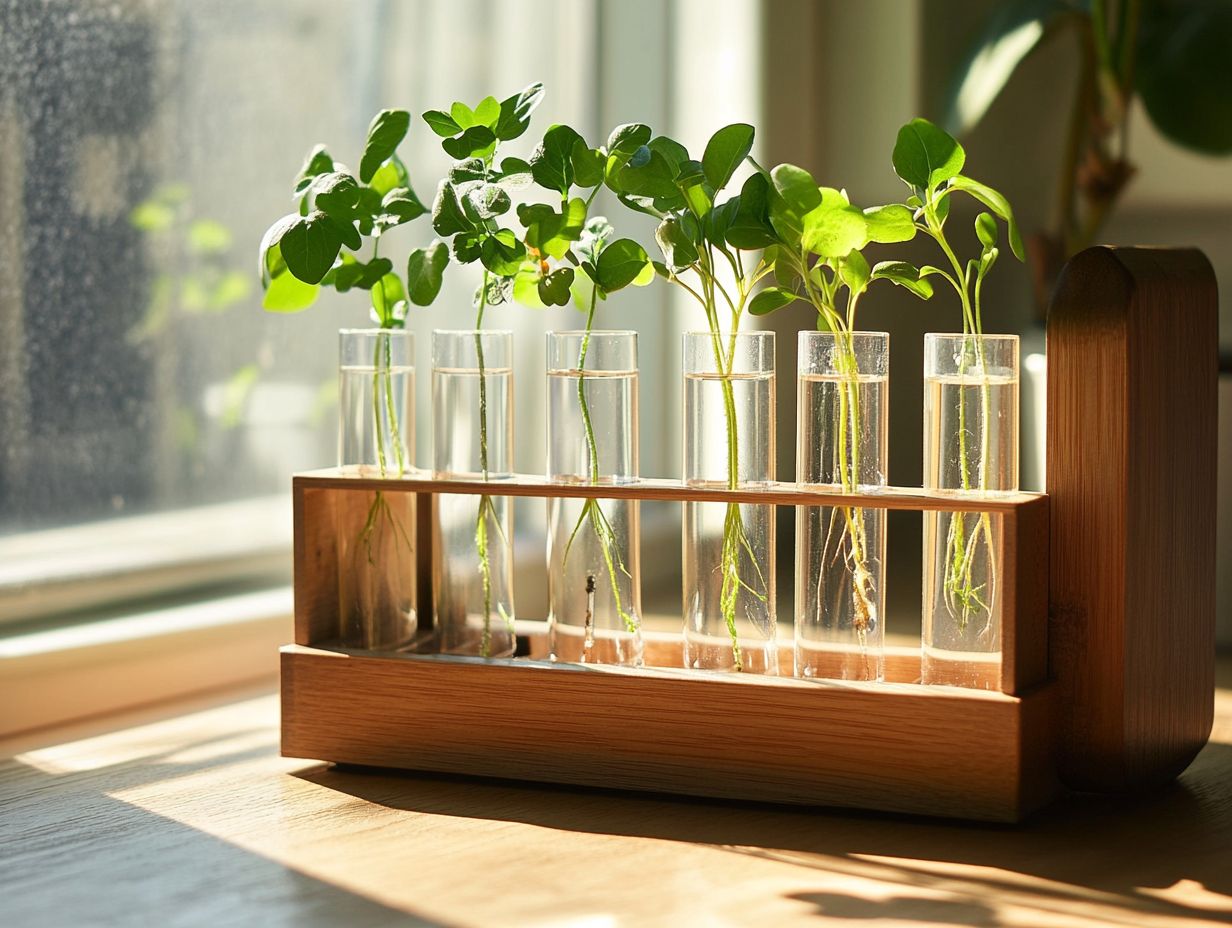
Implementing best practices for plant growth is essential for achieving successful propagation, as these techniques facilitate the seamless transition of cuttings into thriving plants.
Understanding the significance of proper cutting techniques is key to increasing the chances of new growth. For instance, taking cuttings from healthy, disease-free parent plants lays a solid foundation for success. Selecting the right medium be it soil or water can significantly influence root development.
Regularly check moisture levels and provide adequate light. These are vital propagation tips that support vigorous growth.
By integrating these strategies, you can cultivate an environment where your cuttings not only flourish but also evolve into vibrant, resilient plants.
Common Mistakes to Avoid
- Avoiding overly moist conditions that can lead to rot.
- Neglecting to use sterilized tools during the cutting process.
- Ignoring humidity levels and temperature stability.
Avoiding common mistakes during the propagation process is essential for ensuring a successful experience. Errors at this stage can lead to poor growth and unhealthy plants, undermining your hard work and dedication.
By focusing on the details, you’ll create thriving plants!
Problems and Solutions
Common challenges in propagation, such as rot, insufficient root development, and environmental stress, often come your way, but rest assured that each of these issues has effective solutions.
To tackle rot, ensure your cuttings aren t overly moist and that their containers boast excellent drainage. Using sterilized tools, such as sharp shears, during the cutting process can significantly lower the risk of introducing harmful pathogens.
If you find yourself facing underdeveloped roots, keeping a close eye on humidity levels and providing a stable temperature and proper air quality can greatly encourage healthy growth. Applying rooting hormones substances that help cuttings grow roots faster can also stimulate development, helping to establish a strong foundation for your plants.
To combat stress from inconsistent lighting or drafts, place your cuttings in a spot with soft, indirect light and ensure stable ambient conditions. This is vital for plant health, promoting their overall health and vitality!
Frequently Asked Questions
What is a propagation station; it’s ideal for plant care and propagation?
A propagation station is a container or tray specifically designed for propagating or growing plants in optimal conditions that ensure better health. It typically consists of multiple compartments for holding plant cuttings, including stem cuttings and leaf cuttings, as well as a reservoir for water and nutrients.
Why should I use a propagation station for my indoor plants?
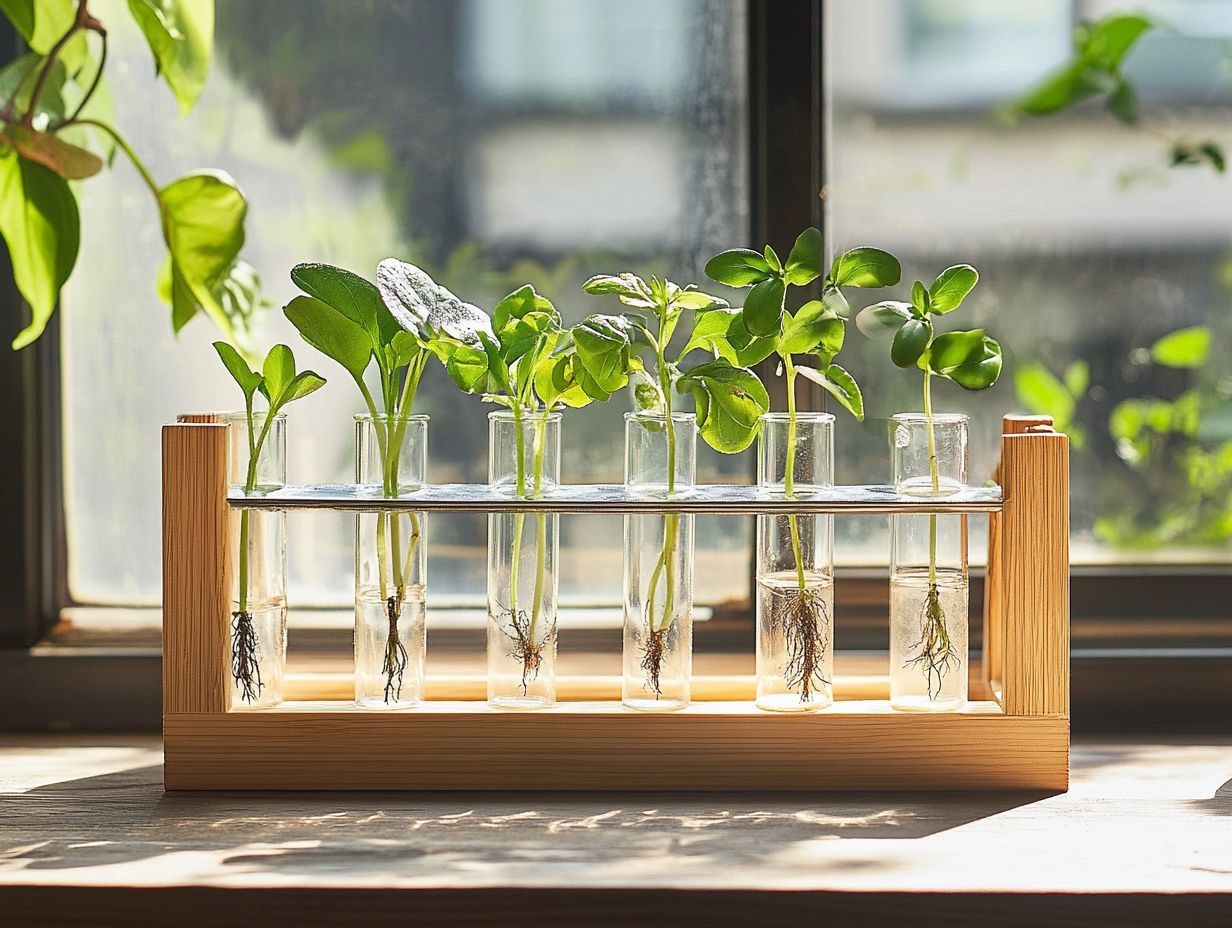
A propagation station provides an ideal environment for plant propagation, with controlled moisture levels and protection from external elements. It also helps to maximize space and organization, making it easier to care for multiple plants at once.
What types of plants can I propagate in a propagation station?
Propagation stations are suitable for a variety of plant species, including succulents, herbs, and leafy greens. They work well for plants like Pothos varieties and Rubber Trees that can propagate through cuttings or seeds, and are especially beneficial for plants that require high humidity.
How do I use a propagation station for my indoor plants?
To use a propagation station, start by filling the reservoir with water and adding any necessary nutrients. Then, place your plant cuttings or seeds in the designated compartments, making sure they have enough space to grow. Monitor the water levels and adjust as needed.
Start propagating today and watch your indoor garden thrive!
Do I need any special equipment to use a propagation station?
No, you do not need any special equipment to use a propagation station. However, having a spray bottle for misting can be very helpful.
Consider getting small gardening tools for planting and a grow light to provide extra light for your plants. These tools can make your propagation adventure even more successful!
Can I reuse a propagation station for different plants?
Yes, you can reuse a propagation station for different plants. Make sure to clean it thoroughly between uses to stop the spread of diseases or pests.
Use a separate station for plants that have different water and food needs.

